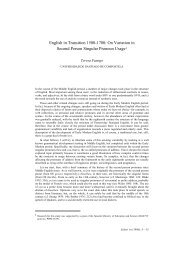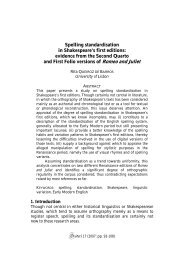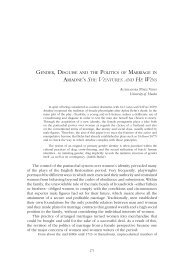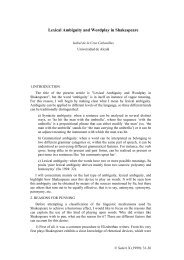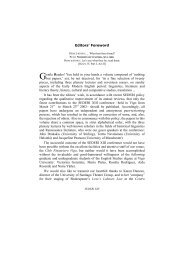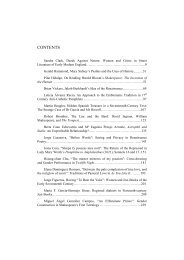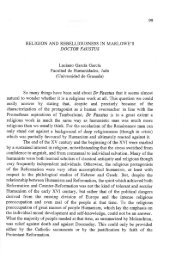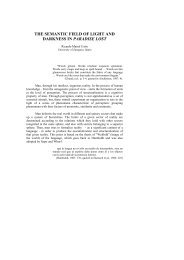'Silence is the perfectest herald of joy': The Claudio-Hero ... - SEDERI
'Silence is the perfectest herald of joy': The Claudio-Hero ... - SEDERI
'Silence is the perfectest herald of joy': The Claudio-Hero ... - SEDERI
You also want an ePaper? Increase the reach of your titles
YUMPU automatically turns print PDFs into web optimized ePapers that Google loves.
‘Silence <strong>is</strong> <strong>the</strong> <strong>perfectest</strong> <strong>herald</strong> <strong>of</strong> joy’:<br />
<strong>The</strong> <strong>Claudio</strong>-<strong>Hero</strong> Plot in Kenneth Branagh’s<br />
Much Ado About Nothing<br />
S<strong>of</strong>ía Muñoz Valdivieso<br />
UNIVERSIDAD DE MÁLAGA<br />
Shakespeare’s comedy Much Ado About Nothing has dark and problematic areas in character and<br />
mode in <strong>the</strong> story <strong>of</strong> <strong>Claudio</strong> and <strong>Hero</strong>, who are sometimes described as superficial and ordinary<br />
(<strong>Hero</strong> <strong>is</strong> <strong>the</strong> quintessence <strong>of</strong> docility and <strong>Claudio</strong> <strong>is</strong> mean-spirited and cruel to her), and whose<br />
wedding at <strong>the</strong> end <strong>of</strong> <strong>the</strong> play <strong>is</strong> seen as an inadequate romantic solution. Kenneth Branagh’s 1993<br />
film version <strong>of</strong> <strong>the</strong> play tries to d<strong>is</strong>solve <strong>the</strong> dark strain <strong>of</strong> cruelty in <strong>the</strong> <strong>Claudio</strong>-<strong>Hero</strong> story so as to<br />
subsume it into <strong>the</strong> bright festivity that shines through <strong>the</strong> action. He cuts some <strong>of</strong> <strong>Claudio</strong>’s harsh<br />
lines, foregrounds (by <strong>the</strong> use <strong>of</strong> close-ups) both h<strong>is</strong> silences and those <strong>of</strong> <strong>Hero</strong> that can best engage<br />
our sympathy for <strong>the</strong>m, and uses <strong>the</strong> power <strong>of</strong> <strong>the</strong> cinematic image to dimin<strong>is</strong>h <strong>the</strong> troubling aspects<br />
<strong>of</strong> <strong>the</strong>ir story. Thus, he uses silence, understood in a wide sense as both lack <strong>of</strong> words and cinematic<br />
foregrounding, to d<strong>is</strong>pel darkeness and make <strong>the</strong> final happiness <strong>of</strong> <strong>the</strong> characters acceptable. We<br />
could <strong>the</strong>n describe h<strong>is</strong> approach to <strong>the</strong> <strong>Claudio</strong>-<strong>Hero</strong> story in h<strong>is</strong> film with <strong>Claudio</strong>’s words in 2.1:<br />
“Silence <strong>is</strong> <strong>the</strong> <strong>perfectest</strong> <strong>herald</strong> <strong>of</strong> joy. I were but little happy if I could say how much”.<br />
Most critics agree that <strong>the</strong> <strong>Claudio</strong>-<strong>Hero</strong> story <strong>is</strong> <strong>the</strong> ‘main plot’ in Much Ado About Nothing,<br />
“although <strong>the</strong>y literally or figuratively put <strong>the</strong> term in quotation marks and are quick to point out that<br />
Beatrice and Benedick overshadow th<strong>is</strong> ‘plot’, however ‘main’ it <strong>is</strong>” (Neely, 56). Branagh’s film<br />
shows <strong>Claudio</strong> and <strong>Hero</strong> toge<strong>the</strong>r on more occasions that <strong>the</strong> text <strong>of</strong> <strong>the</strong> play suggests, in an attempt<br />
to bring <strong>the</strong>m more to <strong>the</strong> center <strong>of</strong> <strong>the</strong> action. As Branagh himself has indicated, “<strong>the</strong>re <strong>is</strong> room in a<br />
movie to give a different kind <strong>of</strong> space to <strong>the</strong> <strong>Claudio</strong>/<strong>Hero</strong> plot” (Branagh, vii), and in <strong>the</strong> lineup <strong>of</strong><br />
portraits on <strong>the</strong> film poster <strong>Hero</strong> and <strong>Claudio</strong> take <strong>the</strong> central position. <strong>The</strong> text <strong>of</strong> <strong>the</strong> play introduces<br />
<strong>the</strong>ir romantic attachment halfway through <strong>the</strong> first scene, when all <strong>the</strong> main characters have been<br />
presented and Beatrice and Benedick have had <strong>the</strong>ir first verbal skirm<strong>is</strong>h. Branagh chooses to call <strong>the</strong><br />
viewers’ attention to <strong>the</strong>ir love in <strong>the</strong> very opening <strong>of</strong> <strong>the</strong> film. When Leonato reads <strong>the</strong> letter about<br />
<strong>the</strong> victorious army and <strong>Claudio</strong>’s name <strong>is</strong> mentioned, <strong>the</strong> close-up <strong>of</strong> <strong>Hero</strong>’s blushing face tells us<br />
that she <strong>is</strong> already interested in <strong>the</strong> young man (no such suggestion ex<strong>is</strong>ts in <strong>the</strong> text <strong>of</strong> play). “[T]he<br />
camera’s ability to reg<strong>is</strong>ter feeling in an actor’s face” (Jackson, 117) <strong>is</strong> also put to use when <strong>Hero</strong> and<br />
<strong>Claudio</strong> meet for <strong>the</strong> first time in <strong>the</strong> film, and <strong>the</strong>ir brief exchange <strong>of</strong> looks <strong>is</strong> a silent conversation<br />
that <strong>the</strong> camera records for us. Later in <strong>the</strong> film, when <strong>Claudio</strong> <strong>is</strong> confessing h<strong>is</strong> love to Benedick,<br />
<strong>Hero</strong> <strong>is</strong> shown lingering on a balcony as she looks down on <strong>Claudio</strong>, her attentive silence as eloquent<br />
as <strong>Claudio</strong>’s own words. Thus from <strong>the</strong> beginning <strong>the</strong> film foregrounds her presence in silence and<br />
suggests her feelings for <strong>Claudio</strong>. 1<br />
1 In <strong>the</strong> text <strong>of</strong> <strong>the</strong> play, <strong>Hero</strong> <strong>is</strong> present in <strong>the</strong> first scene but remains silent except for a sentence clarifying <strong>the</strong> meaning <strong>of</strong><br />
Beatrice’s “Signor Mountanto” (“My cousin means Signor Benedick”). In Rena<strong>is</strong>sance terms her silence would be <strong>the</strong> sign that<br />
she <strong>is</strong> a dutiful daughter and a modest maid. She never initiates a conversation and only responds when directly or indirectly<br />
asked. She <strong>is</strong> <strong>the</strong> counterpart <strong>of</strong> Beatrice, whose silence, Don Pedro indicates, “most <strong>of</strong>fends” (2.1, 328).<br />
191
192 SOFÍA MUÑOZ VALDIVIESO<br />
Much Ado About Nothing <strong>is</strong> different in structure from Shakespeare’s o<strong>the</strong>r so-called romantic<br />
comedies, which typically begin with <strong>the</strong> lovers in a undesirable situation that brings <strong>the</strong>m apart, so<br />
that <strong>the</strong> story leads toward <strong>the</strong>ir coming toge<strong>the</strong>r. In Much Ado, Beatrice and Benedick in a sense<br />
follow th<strong>is</strong> pattern in that <strong>the</strong>y overcome <strong>the</strong>ir own personality in order to come toge<strong>the</strong>r; <strong>the</strong> main<br />
lovers, on <strong>the</strong> o<strong>the</strong>r hand, present a different pattern. <strong>The</strong> play opens in happiness and celebration,<br />
and <strong>Hero</strong> and <strong>Claudio</strong> have no obstacles to overcome. However, more than half way through <strong>the</strong> play<br />
<strong>the</strong> festive mood <strong>is</strong> broken and a dark shadow <strong>of</strong> cruelty <strong>is</strong> cast over Messina, 2 when <strong>Claudio</strong> <strong>is</strong><br />
deceived into believing that <strong>Hero</strong> has betrayed him, and rejects h<strong>is</strong> bride at <strong>the</strong> altar in Act 4. <strong>The</strong><br />
problematic areas in <strong>the</strong> comic structure <strong>of</strong> <strong>the</strong> play have to do with <strong>the</strong> character <strong>of</strong> <strong>Claudio</strong> and with<br />
<strong>the</strong> resolution <strong>of</strong> <strong>the</strong>ir story. As critics have frequently indicated, <strong>the</strong> festive ending in <strong>the</strong> play <strong>is</strong><br />
mainly centered on Beatrice and Benedick. <strong>The</strong>ir union <strong>is</strong> sat<strong>is</strong>factory and can be considered a<br />
marriage <strong>of</strong> true minds. <strong>The</strong> union <strong>of</strong> <strong>Hero</strong> and <strong>Claudio</strong> <strong>is</strong> much less sat<strong>is</strong>factory, especially for<br />
contemporary readers <strong>of</strong> <strong>the</strong> play. As Carol Cook indicates, “<strong>the</strong> play’s attempt to move toward a<br />
comic conclusion and to evade what its plot has exposed places a strain on <strong>the</strong> fifth act, producing a<br />
peculiar shiftiness <strong>of</strong> tone and mode” (198). At <strong>the</strong> end <strong>of</strong> <strong>the</strong> play <strong>the</strong> subm<strong>is</strong>sive <strong>Hero</strong> accepts<br />
without questioning a young man that has repudiated her in <strong>the</strong> most violent terms, and we are<br />
expected to accept a briefly repentant <strong>Claudio</strong> as her ideal husband. (We must remember he <strong>is</strong><br />
repentant not when he learns that she has died <strong>of</strong> sorrow, but when external witnesses confirm that<br />
she has died innocent.) <strong>The</strong> happiness <strong>of</strong> th<strong>is</strong> conventional romantic resolution to <strong>the</strong>ir plot <strong>is</strong><br />
perceived as flawed by many recent critics. 3<br />
In Branagh’s film <strong>the</strong>re <strong>is</strong> no striving to elicit from <strong>the</strong> audience <strong>the</strong> contradictory responses that<br />
postmodern critical readings find in <strong>the</strong> comedies, and thus some critics have objected that “Branagh<br />
has ‘thinned’ h<strong>is</strong> original more than was needed” (Barton, 13), and produced a simplification <strong>of</strong> <strong>the</strong><br />
original play, so that “a vigorously pruned script reduces th<strong>is</strong> dark and complex comedy to a single<br />
idea […] <strong>the</strong> celebration <strong>of</strong> love” (Barr, 39). <strong>The</strong>re <strong>is</strong> no doubt that <strong>the</strong> film “locates Shakespeare’s<br />
play as a comedy firmly within <strong>the</strong> festive tradition ra<strong>the</strong>r than as a precursor to <strong>the</strong> problem plays<br />
that follow” (Crowl, 39). <strong>The</strong> festive mood <strong>is</strong> made clear in <strong>the</strong> rumbustious opening that shows<br />
happy people in an idyllic country atmosphere. In h<strong>is</strong> film Branagh moves <strong>the</strong> location <strong>of</strong> <strong>the</strong> play<br />
from <strong>the</strong> original Messina in dry Silicy to lush Tuscany, and takes what <strong>is</strong> mainly an urban play in <strong>the</strong><br />
original to a sunny rural setting. As Branagh indicates in <strong>the</strong> scriptbook, “<strong>the</strong> play seemed to beg to<br />
live outside, in a vivid, lush countryside” (Branagh, viii). Most <strong>of</strong> <strong>the</strong> scenes are shot outdoors, and<br />
even <strong>the</strong> chapel wedding <strong>is</strong> taken to <strong>the</strong> outside <strong>of</strong> <strong>the</strong> chapel. 4 <strong>The</strong> significant exceptions are <strong>the</strong><br />
sequences with <strong>the</strong> villain Don John at <strong>the</strong> center <strong>of</strong> <strong>the</strong> action, shot in <strong>the</strong> cellar and dark rooms and<br />
corridors <strong>of</strong> what looks like <strong>the</strong> basement <strong>of</strong> <strong>the</strong> villa. (When Don John first tells <strong>Claudio</strong> and <strong>the</strong><br />
Prince that he has something to tell <strong>the</strong>m about <strong>Hero</strong>, <strong>the</strong>y are also indoors.)<br />
Branagh clearly w<strong>is</strong>hes to avoid “<strong>the</strong> troublesome doubts ra<strong>is</strong>ed by <strong>the</strong> character and behavior <strong>of</strong><br />
Shakespeare’s <strong>Claudio</strong>” because <strong>the</strong>y would “complicate and qualify <strong>the</strong> sunny ending <strong>of</strong> [h<strong>is</strong>] film”<br />
(Barton, 11). In <strong>the</strong> play <strong>Claudio</strong> <strong>is</strong> “a young man who behaves abominably to a loving and generous<br />
woman, causes her great suffering, and <strong>the</strong>n, after a perfunctory repentance, <strong>is</strong> d<strong>is</strong>m<strong>is</strong>sed with her<br />
into a happiness he scarcely seems to deserve” (Barton, 11). Branagh’s film version <strong>of</strong> <strong>the</strong> play tries<br />
to s<strong>of</strong>ten <strong>Claudio</strong>’s character in several ways. He casts as <strong>Claudio</strong> a young actor that became widely<br />
known in Peter Weir’s <strong>The</strong> Dead Poets’ Society. In that film he was a sensitive adolescent who fell in<br />
2 <strong>The</strong>re are recent readings that find <strong>the</strong> play’s atmosphere oppressive from <strong>the</strong> beginning. Carol Cook, for instance, speaks <strong>of</strong> <strong>the</strong><br />
rigidity <strong>of</strong> <strong>the</strong> world <strong>of</strong> Messina: “Messina, <strong>the</strong> most soph<strong>is</strong>ticated and urbane society in all Shakespeare’s comedies, <strong>is</strong> also <strong>the</strong><br />
most confined. No moonlit wood or forest <strong>of</strong> Arden <strong>of</strong>fers escape from Messina’s social tensions, and <strong>the</strong> characters’ romantic<br />
and sexual roles are not relieved by opportunities for sexual d<strong>is</strong>gu<strong>is</strong>e” (189).<br />
3 In general th<strong>is</strong> <strong>is</strong> a relevant <strong>is</strong>sue for <strong>the</strong> endings <strong>of</strong> most Shakespearean comedies: “Th<strong>is</strong> contention between proponents <strong>of</strong> a<br />
festive view <strong>of</strong> <strong>the</strong> play and those who find irony, cynic<strong>is</strong>m, darkeness or some o<strong>the</strong>r version <strong>of</strong> problematic qualities in its<br />
resolution <strong>is</strong> not, <strong>of</strong> course, unique to d<strong>is</strong>cussions <strong>of</strong> Much Ado About Nothing. Th<strong>is</strong> <strong>is</strong> a common div<strong>is</strong>ion <strong>of</strong> opinion over<br />
nearly all <strong>the</strong> comedies” (Jensen, 45).<br />
4 In <strong>the</strong> strongly negative review <strong>of</strong> <strong>the</strong> film in <strong>the</strong> American magazine <strong>The</strong> New Yorker we are told that “<strong>the</strong> film glances [at <strong>the</strong><br />
play’s darker threads] but turns away to greet <strong>the</strong> sun; every frame <strong>is</strong> telling American audiences to book a trip to Italy” (quoted<br />
in Coursen, 10).<br />
Sederi VIII (1997)
THE CLAUDIO-HERO PLOT IN BRANAGH’S MUCH ADO ABOUT NOTHING 193<br />
love with <strong>the</strong> <strong>the</strong>ater after performing Puck in A Midsummer Night’s Dream and who committed<br />
suicide when denied <strong>the</strong> opportunity to become an actor. In Branagh’s film, <strong>Claudio</strong> <strong>is</strong>, in keeping<br />
with <strong>the</strong> spirit <strong>of</strong> Shakespeare’s text, a young man barely past adolescence, h<strong>is</strong> beardless face a<br />
reminder <strong>of</strong> h<strong>is</strong> youth and inexperience. Significantly enough, at <strong>the</strong> masked ball in 2.1, while <strong>the</strong><br />
o<strong>the</strong>r characters wear deformed and outrageous masks, h<strong>is</strong> <strong>is</strong> a chubby baby face that looks like a<br />
curly-haired cherubin--<strong>the</strong> mask thus revealing what it hides.<br />
<strong>Claudio</strong> only speaks freely when he <strong>is</strong> with men alone, and h<strong>is</strong> silence in <strong>the</strong> presence <strong>of</strong> women<br />
as well as h<strong>is</strong> tentativeness in stating h<strong>is</strong> feelings for <strong>Hero</strong> can contribute to th<strong>is</strong> image <strong>of</strong> a young<br />
man who <strong>is</strong> much more comfortable in war than in love. Branagh ins<strong>is</strong>ts that he <strong>is</strong> mainly a soldier<br />
and that “<strong>the</strong> instantaneousness <strong>of</strong> <strong>Claudio</strong>’s love for <strong>Hero</strong>, its intensity, <strong>is</strong> not unusual amongst men<br />
for whom death <strong>is</strong> an equal reality” (Branagh, xii). <strong>Claudio</strong> has an idealized v<strong>is</strong>ion <strong>of</strong> romantic love<br />
that can easily swing to its most cynical opposite due to h<strong>is</strong> absolute inexperience. 5 In <strong>the</strong> text <strong>of</strong> <strong>the</strong><br />
play, <strong>the</strong> audience learns what <strong>Claudio</strong> has witnessed through Borachio’s words:<br />
I have tonight wooed Margaret, <strong>the</strong> Lady <strong>Hero</strong>’s gentlewoman, by <strong>the</strong> name <strong>of</strong><br />
<strong>Hero</strong>. She leans me out at her m<strong>is</strong>tress’ chamber window, bids me a thousand times<br />
good night […] <strong>the</strong> Prince, <strong>Claudio</strong> and my master, planted and placed and possessed<br />
by my master Don John, saw afar <strong>of</strong>f in <strong>the</strong> orchard th<strong>is</strong> amiable encounter (3.3, 142-<br />
49).<br />
In <strong>the</strong> film, instead <strong>of</strong> having Boracchio use words to describe <strong>the</strong> scene at <strong>the</strong> window, we see it with<br />
<strong>Claudio</strong> and Don Pedro. It <strong>is</strong> an openly sexual encounter far more graphic than what <strong>is</strong> reported in <strong>the</strong><br />
text <strong>of</strong> <strong>the</strong> play, and we see <strong>Claudio</strong>’s reaction as a mixture <strong>of</strong> rage and sorrow. <strong>The</strong> screenplay says<br />
for th<strong>is</strong> scene: “<strong>Claudio</strong> lets out a cry and makes to run at <strong>the</strong>m but <strong>is</strong> held by Don Pedro and and Don<br />
John [….] Close on <strong>Claudio</strong>’s tears in angry eyes” (Branagh, 56). In <strong>the</strong> play, when <strong>Claudio</strong> <strong>is</strong> first<br />
told about <strong>Hero</strong>’s unfaithfulness by Don John, before seeing it he says: “If I see anything tonight why<br />
I should not marry her, tomorrow, in <strong>the</strong> congregation where I should wed, <strong>the</strong>re will I shame her”,<br />
and Don Pedro joins in in h<strong>is</strong> plan: “And as I wood for <strong>the</strong>e to obtain her, I will join <strong>the</strong>e to d<strong>is</strong>grace<br />
her” (3.2, 117-21; emphas<strong>is</strong> mine). Branagh edits out <strong>the</strong>se words which show <strong>the</strong>ir plan to d<strong>is</strong>grace<br />
<strong>Hero</strong> openly at <strong>the</strong> wedding ceremony <strong>the</strong> following day. In Borachio’s telling <strong>of</strong> <strong>the</strong> ep<strong>is</strong>ode to<br />
Conrad <strong>the</strong>re <strong>is</strong> ano<strong>the</strong>r reference to <strong>the</strong> meditated d<strong>is</strong>grace: “away went <strong>Claudio</strong>, enraged, swore he<br />
would meet her as he was appointed next morning at <strong>the</strong> temple, and <strong>the</strong>re, before <strong>the</strong> whole<br />
congregation, shame her with what he saw o’ernight, and send her home again without a husband”<br />
(3.3, 156-61). 6 In <strong>the</strong> film, Borachio only says: “Away went <strong>Claudio</strong>, enraged”, and <strong>the</strong> reference to<br />
<strong>Claudio</strong>’s plan to shame her has again been cut. In <strong>the</strong> text <strong>of</strong> <strong>the</strong> play <strong>Claudio</strong> also sounds ra<strong>the</strong>r<br />
callous in 5.1, in h<strong>is</strong> reaction to Benedick’s challenge after <strong>the</strong> death <strong>of</strong> <strong>Hero</strong>. He takes it in jest, as if<br />
he made nothing <strong>of</strong> <strong>the</strong> reason behind it (<strong>Hero</strong>’s death), and it takes some effort on Benedick’s part to<br />
convince <strong>Claudio</strong> that he <strong>is</strong> in earnest, that it <strong>is</strong> no time for joking. Most <strong>of</strong> th<strong>is</strong> conversation with<br />
Benedick has been cut in <strong>the</strong> film, and “Branagh’s close-up <strong>of</strong> [<strong>Claudio</strong>’s] face, crumbling into<br />
despair as he later learns <strong>of</strong> <strong>Hero</strong>’s guiltlessness” (Moses, 39) <strong>is</strong> an attempt to mitigate h<strong>is</strong> previous<br />
cruelty.<br />
We also get in <strong>the</strong> film an impressive spectacle <strong>of</strong> h<strong>is</strong> penance at <strong>the</strong> tomb <strong>of</strong> <strong>Hero</strong> after he <strong>is</strong> told<br />
<strong>the</strong> truth. Th<strong>is</strong> scene (5.3) <strong>is</strong> one <strong>of</strong> <strong>the</strong> few that have been <strong>of</strong>ten cut radically in performance due to<br />
<strong>the</strong> difficulties <strong>of</strong> staging it. As Stanley Wells indicates, 5.3 <strong>is</strong> “scenically awkward, requiring props<br />
and stage movements at odds with <strong>the</strong> rest <strong>of</strong> <strong>the</strong> play” (quoted in Zitner, 70). It seems that not all<br />
directors have seen its importance, but Branagh devotes some time to showing us <strong>the</strong> suffering in h<strong>is</strong><br />
face while reading <strong>the</strong> epitaph on <strong>Hero</strong>’s tomb. <strong>The</strong> screenplay describes <strong>the</strong> sequence in <strong>the</strong><br />
following terms:<br />
5 Some critics suggest that h<strong>is</strong> easy shift <strong>is</strong> due to an undercurrent <strong>of</strong> anxiety about sexual matters in Messina: “<strong>The</strong> repeated<br />
‘cuckold’ jokes in Much Ado About Nothing point to an underlying anxiety in <strong>the</strong> society <strong>of</strong> <strong>the</strong> play about <strong>the</strong> relations between<br />
men and women, one which <strong>is</strong> brought to <strong>the</strong> surface by <strong>the</strong> developing events in<strong>the</strong> play” (Mangan, 182).<br />
6 As Janice Hays indicates, “in a patriarchal value system that views woman and her sexuality as a man’s exclusive possession,<br />
th<strong>is</strong> infidelity <strong>is</strong> <strong>the</strong> ultimate betrayal, a fundamental wound to male self-esteem” (87).<br />
Sederi VIII (1997)
194 SOFÍA MUÑOZ VALDIVIESO<br />
Point <strong>of</strong> view from <strong>the</strong> Villa <strong>of</strong> a wide shot <strong>of</strong> a cloaked, torched procession<br />
towards HERO’s tomb. Beautiful and sombre, a snake <strong>of</strong> lights against <strong>the</strong> hillside.<br />
We pull back to reveal ANTONIO and HERO in <strong>the</strong> foreground. We move closer to<br />
<strong>the</strong> procession and see DON PEDRO, CLAUDIO, and a choir <strong>of</strong> mourners sing as<br />
<strong>Claudio</strong> weeps before <strong>the</strong> tomb (Branagh, 76).<br />
One critic refers to th<strong>is</strong> sequence as one <strong>of</strong> <strong>the</strong> three BMS’s (Big Memorable Sequences) that<br />
Branagh includes in Much Ado, <strong>the</strong> o<strong>the</strong>r two being <strong>the</strong> opening and <strong>the</strong> closing <strong>of</strong> <strong>the</strong> film. For him,<br />
th<strong>is</strong> BMS “on <strong>the</strong> eve <strong>of</strong> <strong>the</strong> final wedding ceremony, with <strong>Claudio</strong> mourning by <strong>Hero</strong>’s tomb,<br />
accompanied by a choir <strong>of</strong> mourners <strong>of</strong> Mormon Tabernacle proportions” (Skovmand, 9) <strong>is</strong> less<br />
motivated than <strong>the</strong> o<strong>the</strong>r two. In my opinion, Branagh’s motivation in th<strong>is</strong> case <strong>is</strong> strong and clear: he<br />
<strong>is</strong> devoting one long memorable sequence to <strong>the</strong> contritition and repentance <strong>of</strong> <strong>Claudio</strong> obviously to<br />
make him more sympa<strong>the</strong>tic to viewers that will be asked to accept h<strong>is</strong> marriage to <strong>Hero</strong> as a<br />
sat<strong>is</strong>factory happy solution. Branagh <strong>is</strong> aware that “<strong>Hero</strong>’s funeral <strong>is</strong> dramatically necessary as<br />
<strong>Claudio</strong>’s ritual <strong>of</strong> expiation” (Cook, 198). In fact, h<strong>is</strong> emphas<strong>is</strong> on <strong>Claudio</strong>’s repentance tries to<br />
show us that <strong>the</strong>re <strong>is</strong> “a change in <strong>Claudio</strong> sufficient to warrant h<strong>is</strong> good fortune in <strong>the</strong> next scene,<br />
where <strong>Hero</strong> <strong>is</strong> restored to him” (Cook, 198).<br />
Branagh devotes an extremely long final sequence to a dance that gives shape to Benedick’s final<br />
words in <strong>the</strong> text, “Strike up, pipers”. 7 Some critics <strong>of</strong> <strong>the</strong> film have in fact objected to its very<br />
length, suggesting that by abbreviating it “he might have found room for more <strong>of</strong> Shakespeare’s text”<br />
(Barton, 12), and <strong>the</strong>y have also objected to its implications that <strong>the</strong> unsolved <strong>is</strong>sues at <strong>the</strong> end <strong>of</strong> <strong>the</strong><br />
play “are swept aside in <strong>the</strong> euphoria <strong>of</strong> a celebration which at times threatens to assume <strong>the</strong><br />
proportions <strong>of</strong> a presidential ticker-tape parade, complete with triumphant band music” (Barr, 26).<br />
Th<strong>is</strong> celebratory dance only leaves Don Pedro out after Benedick’s injunction “Get <strong>the</strong>e a wife”<br />
(Antonio dances with Ursula and Leonato with Margaret), but o<strong>the</strong>rw<strong>is</strong>e brings in even Margaret, a<br />
character that <strong>the</strong> text marginalizes somewhat for her unwilling participation in <strong>the</strong> deception <strong>of</strong><br />
<strong>Claudio</strong>. 8 Clearly <strong>the</strong> long whirling around <strong>of</strong> happy characters as <strong>the</strong> camera moves away to a bird’seye<br />
view <strong>of</strong> <strong>the</strong> villa reveals Branagh’s reading <strong>of</strong> <strong>the</strong> text: th<strong>is</strong> all-embracing celebratory dance that<br />
involves all <strong>the</strong> characters in Messina <strong>is</strong> <strong>the</strong> film’s way <strong>of</strong> suggesting all-embracing happiness, and it<br />
<strong>is</strong> <strong>the</strong>refore <strong>the</strong> final move on <strong>the</strong> director’s part to d<strong>is</strong>solve any dark, unpleasant strains that may<br />
remain at <strong>the</strong> end <strong>of</strong> <strong>the</strong> story:<br />
All <strong>the</strong> couples dance and sing merrily in front <strong>of</strong> us, and we see one joyous image<br />
<strong>of</strong> each one <strong>of</strong> <strong>the</strong>m […] We carry on from <strong>the</strong> Chapel Yard, in through <strong>the</strong> house<br />
[…] and <strong>the</strong>n quickly, high into <strong>the</strong> air where we leave <strong>the</strong> people and <strong>the</strong> dancing to<br />
r<strong>is</strong>e above <strong>the</strong> house, catch <strong>the</strong> late afternoon sun, <strong>the</strong> sound <strong>of</strong> happiness flouting on<br />
<strong>the</strong> air, and a breathtaking view <strong>of</strong> fairy tale countryside (Branagh, 83).<br />
Branagh’s purpose in <strong>the</strong> film has been to make “Shakespeare’s comedy alive on <strong>the</strong> screen rich with<br />
romance and humor in order to appeal to a wide international audience” (Crowl, 39). <strong>The</strong> success <strong>of</strong><br />
<strong>the</strong> film at <strong>the</strong> box <strong>of</strong>fice and its reviews in <strong>the</strong> popular press show that Branagh has suceeded in<br />
creating a wider audience for a Shakespearean comedy than ever before, and despite <strong>the</strong> objections <strong>of</strong><br />
pur<strong>is</strong>ts to its simplification <strong>of</strong> <strong>the</strong> problematic areas in <strong>the</strong> play, on <strong>the</strong> whole we can say that in h<strong>is</strong><br />
Much Ado About Nothing Branagh can “convert all our potential critical sounds <strong>of</strong> woe ‘Into Hey<br />
nonny, nonny’” (Crowl, 40). As Anne Barton anticipated in her early review, <strong>the</strong> film was a great<br />
success and made “many people--especially <strong>the</strong> young--understand that Shakespeare can be vital,<br />
interesting, moving and fun” (13).<br />
7 Ending a comedy in a marriage dance <strong>is</strong> common in Shakespeare, although in Much Ado <strong>the</strong>re <strong>is</strong> one “nuptial irregularity: <strong>the</strong><br />
dancing begins even before <strong>the</strong> weddings are celebrated” (Neely, 56).<br />
8 “<strong>The</strong> ambiguity <strong>of</strong> Margaret’s role in Borachio’s plot has caused some consternation among critics” (Cook, 199) since Leonato’s<br />
words in <strong>the</strong> final scene <strong>of</strong> <strong>the</strong> play suggest “that Margaret <strong>is</strong> made to bear <strong>Claudio</strong>’s and Don Pedro’s guilt” (Cook, 199). In <strong>the</strong><br />
text <strong>of</strong> <strong>the</strong> play she shows no sign <strong>of</strong> concern about her complicity when we see her after <strong>the</strong> d<strong>is</strong>rupted wedding ceremony in 5.2<br />
having a witty exchange with Benedick. In <strong>the</strong> play th<strong>is</strong> speech has been cut, and in general her problematic role “can be<br />
negotiated more deftly in <strong>the</strong> cinema (with some cutting and <strong>the</strong> placing <strong>of</strong> reaction shots) than <strong>is</strong> usual on stage” (Jackson,<br />
117).<br />
Sederi VIII (1997)
THE CLAUDIO-HERO PLOT IN BRANAGH’S MUCH ADO ABOUT NOTHING 195<br />
WORKS CITED<br />
Barr, David. 1994: Much Ado About Nothing. Engl<strong>is</strong>h Review 4.3 (Feb): 26-28.<br />
Barton, Anne. 1993: Shakespeare in <strong>the</strong> Sun. <strong>The</strong> New York Review <strong>of</strong> Books May 27: 11-13.<br />
Branagh, Kenneth. 1993: Much Ado About Nothing by William Shakespeare: Screenplay,<br />
Introduction, and Notes on <strong>the</strong> Making <strong>of</strong> <strong>the</strong> Film by Kenneth Branagh. London: Chato &<br />
Windus.<br />
Cook, Carol. 1986: ‘<strong>The</strong> Sign and Semblance <strong>of</strong> Her Honor’: Reading Gender Difference in Much<br />
Ado about Nothing. PMLA 101: 186-202.<br />
Coursen, H. R. 1993: <strong>The</strong> Critical Reception <strong>of</strong> Branagh’s Much Ado About Nothing. Shakespeare in<br />
<strong>the</strong> Classroom 1.2 (Autumn): 8-11.<br />
Crowl, Samuel. Much Ado About Nothing. 1993: Shakespeare Bulletin 11.3 (Summer): 39-40.<br />
Davies, Anthony, and Staley Wells (eds). 1994: Shakespeare and <strong>the</strong> Moving Image: <strong>The</strong> Plays on<br />
Film and Telev<strong>is</strong>ion. Cambridge: Cambridge UP.<br />
Hays, Janice. 1980: Those ‘s<strong>of</strong>t and delicate desires’: Much Ado and <strong>the</strong> D<strong>is</strong>trust <strong>of</strong> Women. > Lenz,<br />
Carolyn Ruth Swift, Gayle Greene and Carol Thoma Neely eds: 79-99.<br />
Jackson, Russell. 1994: Shakespeare’s Comedies on Film. > Davies, Anthony, and Stanley Wells eds:<br />
99-120.<br />
Jensen, Ejner J. Shakespeare and <strong>the</strong> Ends <strong>of</strong> Comedy. Bloomington: Indiana UP, 1991.<br />
Lenz, Carolyn Ruth Swift, Gayle Greene and Carol Thoma Neely (eds). 1980: <strong>The</strong> Woman’s Part:<br />
Femin<strong>is</strong>t Critic<strong>is</strong>m <strong>of</strong> Shakespeare. Chicago: U <strong>of</strong> Illino<strong>is</strong> P.<br />
Mangan, Michael. A Preface to Shakespeare’s Comedies: 1594-1603. London: Longman, 1996.<br />
Moses, Carol. Kenneth Branagh’s Much Ado About Nothing: Shakespearean Comedy as<br />
Shakespearean Romance. 1996: Shakespeare Bulletin 14.1 (Winter): 38-40.<br />
Neely, Carol Thomas. 1985: Broken Nuptials in Shakespeare. Yale: Yale UP.<br />
Shakespeare, William. 1993: Much Ado About Nothing. Ed Sheldon P. Zitner. Oxford: Oxford UP.<br />
Skovmand, Michael. 1994: Introduction, with a D<strong>is</strong>cussion <strong>of</strong> Branagh and Much Ado. > Skovmand,<br />
Michael ed: 7-12.<br />
Skovmand, Micheal (ed). 1994: Screen Shakespeare. Aarthus: Aarthus UP.<br />
Zitner, Sheldon P. 1993: Introduction. Much Ado About Nothing. Oxford: Oxford UP.<br />
* * *<br />
Sederi VIII (1997)



